Managing Human Capital and leadership : Sainsbury
VerifiedAdded on 2021/02/20
|14
|4955
|37
AI Summary
Contribute Materials
Your contribution can guide someone’s learning journey. Share your
documents today.
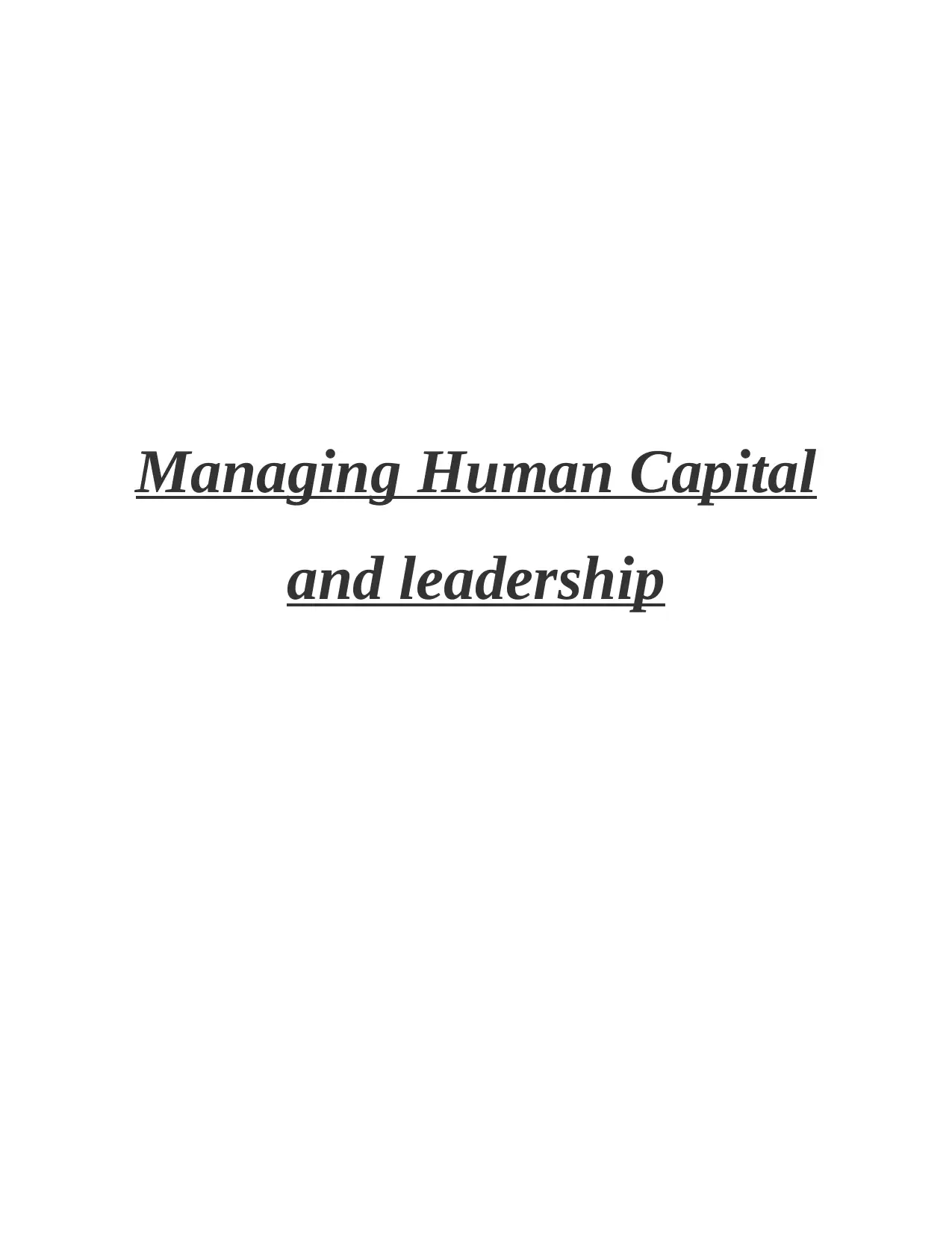
Managing Human Capital
and leadership
and leadership
Secure Best Marks with AI Grader
Need help grading? Try our AI Grader for instant feedback on your assignments.
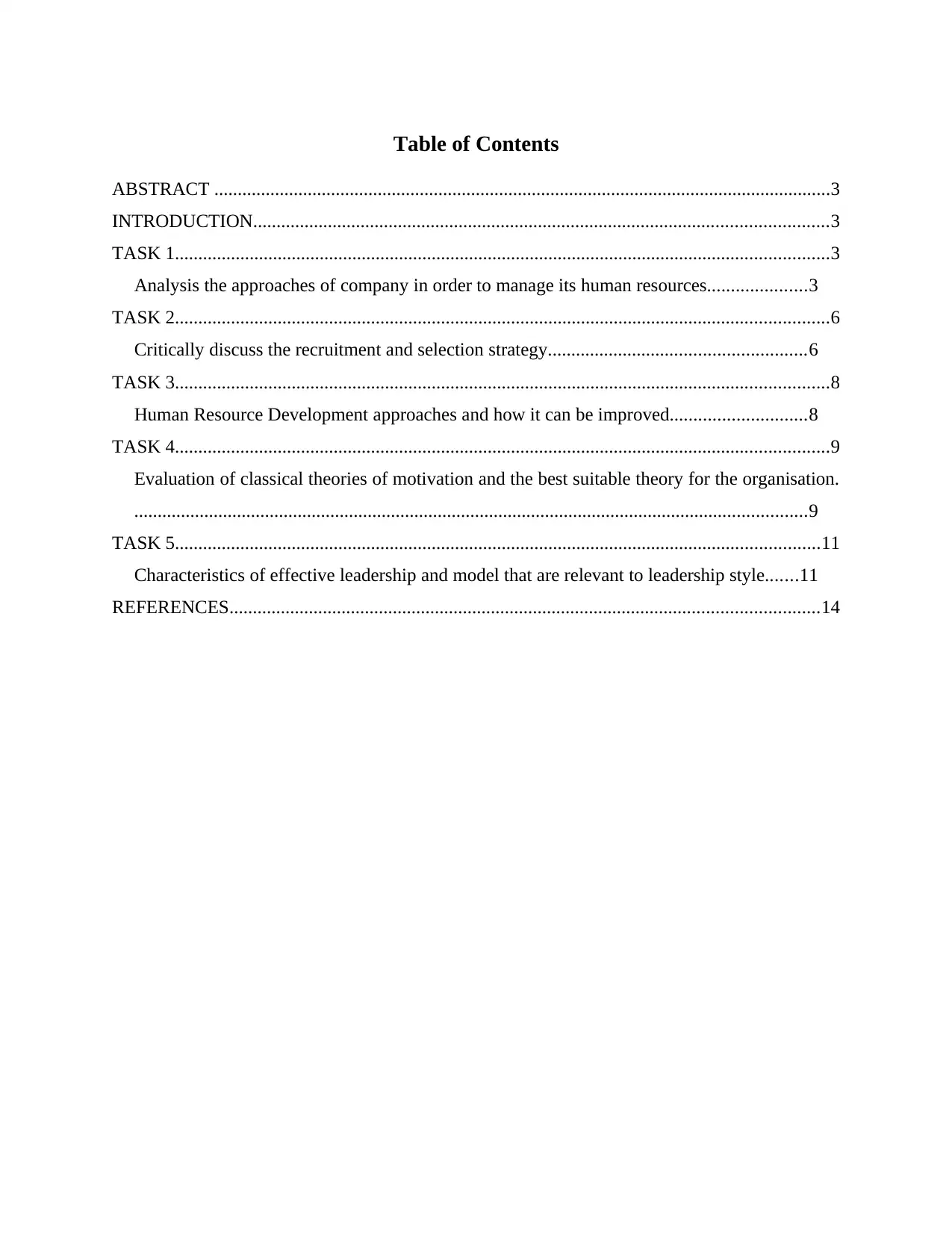
Table of Contents
ABSTRACT ....................................................................................................................................3
INTRODUCTION...........................................................................................................................3
TASK 1............................................................................................................................................3
Analysis the approaches of company in order to manage its human resources.....................3
TASK 2............................................................................................................................................6
Critically discuss the recruitment and selection strategy.......................................................6
TASK 3............................................................................................................................................8
Human Resource Development approaches and how it can be improved.............................8
TASK 4............................................................................................................................................9
Evaluation of classical theories of motivation and the best suitable theory for the organisation.
................................................................................................................................................9
TASK 5..........................................................................................................................................11
Characteristics of effective leadership and model that are relevant to leadership style.......11
REFERENCES..............................................................................................................................14
ABSTRACT ....................................................................................................................................3
INTRODUCTION...........................................................................................................................3
TASK 1............................................................................................................................................3
Analysis the approaches of company in order to manage its human resources.....................3
TASK 2............................................................................................................................................6
Critically discuss the recruitment and selection strategy.......................................................6
TASK 3............................................................................................................................................8
Human Resource Development approaches and how it can be improved.............................8
TASK 4............................................................................................................................................9
Evaluation of classical theories of motivation and the best suitable theory for the organisation.
................................................................................................................................................9
TASK 5..........................................................................................................................................11
Characteristics of effective leadership and model that are relevant to leadership style.......11
REFERENCES..............................................................................................................................14
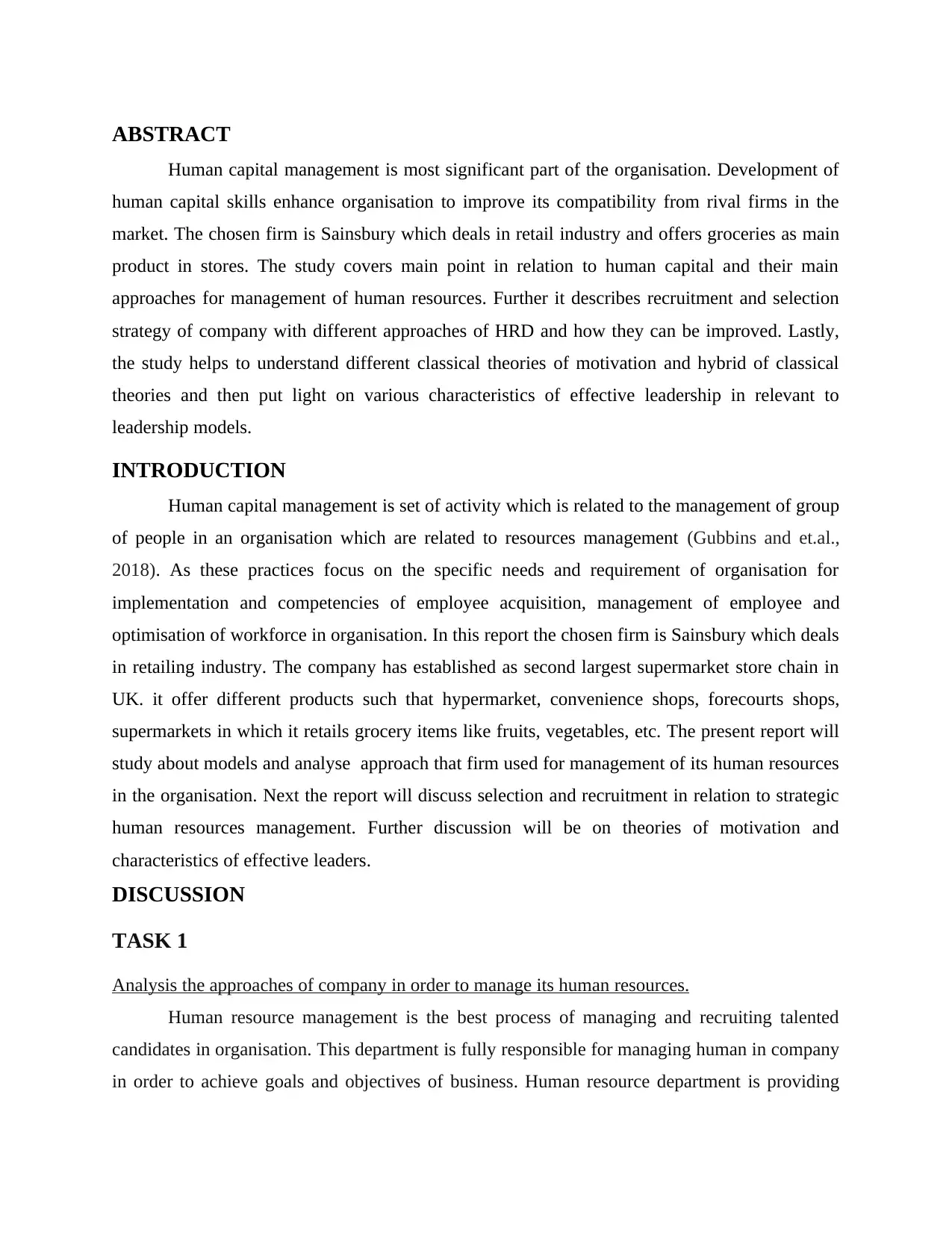
ABSTRACT
Human capital management is most significant part of the organisation. Development of
human capital skills enhance organisation to improve its compatibility from rival firms in the
market. The chosen firm is Sainsbury which deals in retail industry and offers groceries as main
product in stores. The study covers main point in relation to human capital and their main
approaches for management of human resources. Further it describes recruitment and selection
strategy of company with different approaches of HRD and how they can be improved. Lastly,
the study helps to understand different classical theories of motivation and hybrid of classical
theories and then put light on various characteristics of effective leadership in relevant to
leadership models.
INTRODUCTION
Human capital management is set of activity which is related to the management of group
of people in an organisation which are related to resources management (Gubbins and et.al.,
2018). As these practices focus on the specific needs and requirement of organisation for
implementation and competencies of employee acquisition, management of employee and
optimisation of workforce in organisation. In this report the chosen firm is Sainsbury which deals
in retailing industry. The company has established as second largest supermarket store chain in
UK. it offer different products such that hypermarket, convenience shops, forecourts shops,
supermarkets in which it retails grocery items like fruits, vegetables, etc. The present report will
study about models and analyse approach that firm used for management of its human resources
in the organisation. Next the report will discuss selection and recruitment in relation to strategic
human resources management. Further discussion will be on theories of motivation and
characteristics of effective leaders.
DISCUSSION
TASK 1
Analysis the approaches of company in order to manage its human resources.
Human resource management is the best process of managing and recruiting talented
candidates in organisation. This department is fully responsible for managing human in company
in order to achieve goals and objectives of business. Human resource department is providing
Human capital management is most significant part of the organisation. Development of
human capital skills enhance organisation to improve its compatibility from rival firms in the
market. The chosen firm is Sainsbury which deals in retail industry and offers groceries as main
product in stores. The study covers main point in relation to human capital and their main
approaches for management of human resources. Further it describes recruitment and selection
strategy of company with different approaches of HRD and how they can be improved. Lastly,
the study helps to understand different classical theories of motivation and hybrid of classical
theories and then put light on various characteristics of effective leadership in relevant to
leadership models.
INTRODUCTION
Human capital management is set of activity which is related to the management of group
of people in an organisation which are related to resources management (Gubbins and et.al.,
2018). As these practices focus on the specific needs and requirement of organisation for
implementation and competencies of employee acquisition, management of employee and
optimisation of workforce in organisation. In this report the chosen firm is Sainsbury which deals
in retailing industry. The company has established as second largest supermarket store chain in
UK. it offer different products such that hypermarket, convenience shops, forecourts shops,
supermarkets in which it retails grocery items like fruits, vegetables, etc. The present report will
study about models and analyse approach that firm used for management of its human resources
in the organisation. Next the report will discuss selection and recruitment in relation to strategic
human resources management. Further discussion will be on theories of motivation and
characteristics of effective leaders.
DISCUSSION
TASK 1
Analysis the approaches of company in order to manage its human resources.
Human resource management is the best process of managing and recruiting talented
candidates in organisation. This department is fully responsible for managing human in company
in order to achieve goals and objectives of business. Human resource department is providing
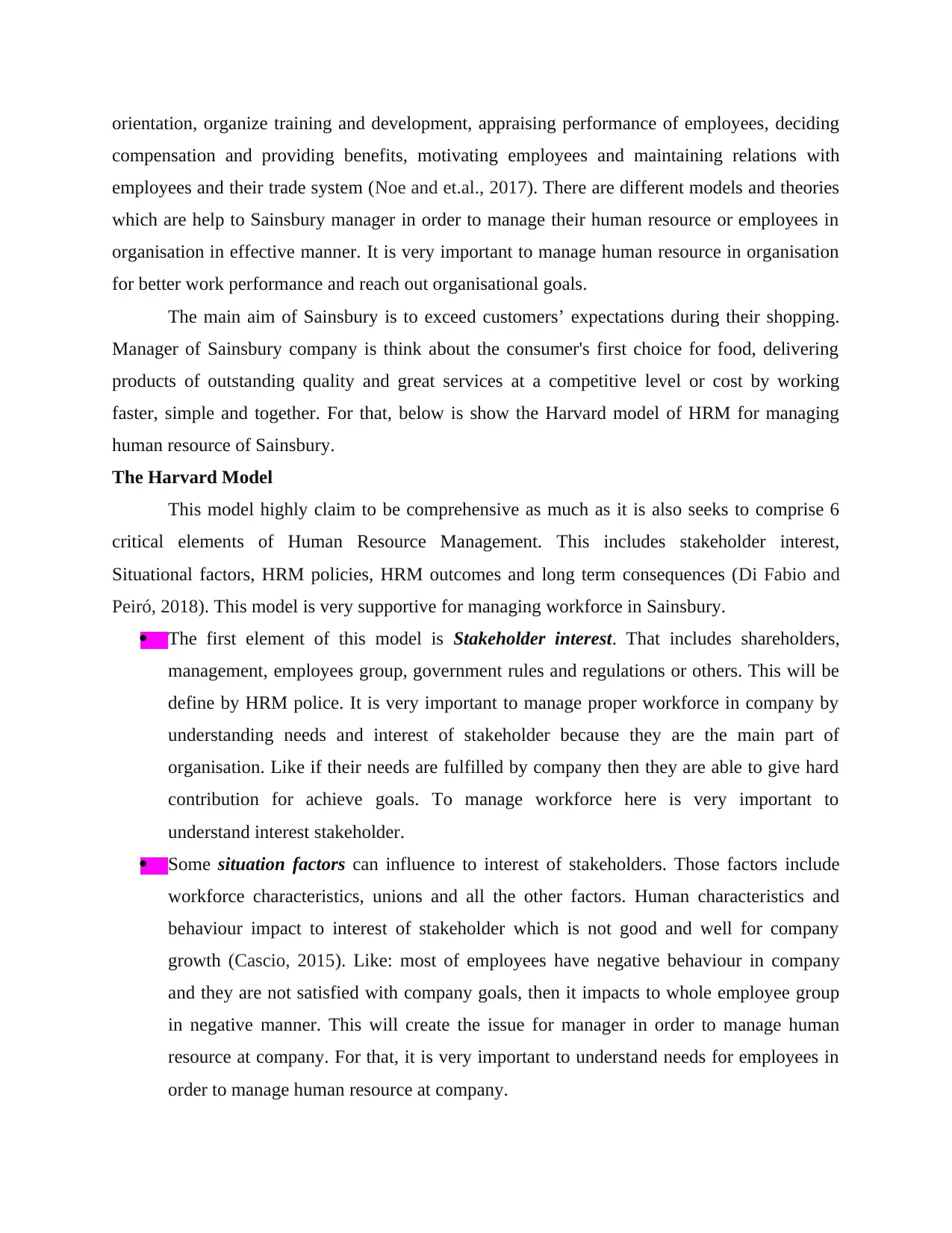
orientation, organize training and development, appraising performance of employees, deciding
compensation and providing benefits, motivating employees and maintaining relations with
employees and their trade system (Noe and et.al., 2017). There are different models and theories
which are help to Sainsbury manager in order to manage their human resource or employees in
organisation in effective manner. It is very important to manage human resource in organisation
for better work performance and reach out organisational goals.
The main aim of Sainsbury is to exceed customers’ expectations during their shopping.
Manager of Sainsbury company is think about the consumer's first choice for food, delivering
products of outstanding quality and great services at a competitive level or cost by working
faster, simple and together. For that, below is show the Harvard model of HRM for managing
human resource of Sainsbury.
The Harvard Model
This model highly claim to be comprehensive as much as it is also seeks to comprise 6
critical elements of Human Resource Management. This includes stakeholder interest,
Situational factors, HRM policies, HRM outcomes and long term consequences (Di Fabio and
Peiró, 2018 ). This model is very supportive for managing workforce in Sainsbury.
The first element of this model is Stakeholder interest. That includes shareholders,
management, employees group, government rules and regulations or others. This will be
define by HRM police. It is very important to manage proper workforce in company by
understanding needs and interest of stakeholder because they are the main part of
organisation. Like if their needs are fulfilled by company then they are able to give hard
contribution for achieve goals. To manage workforce here is very important to
understand interest stakeholder.
Some situation factors can influence to interest of stakeholders. Those factors include
workforce characteristics, unions and all the other factors. Human characteristics and
behaviour impact to interest of stakeholder which is not good and well for company
growth (Cascio, 2015). Like: most of employees have negative behaviour in company
and they are not satisfied with company goals, then it impacts to whole employee group
in negative manner. This will create the issue for manager in order to manage human
resource at company. For that, it is very important to understand needs for employees in
order to manage human resource at company.
compensation and providing benefits, motivating employees and maintaining relations with
employees and their trade system (Noe and et.al., 2017). There are different models and theories
which are help to Sainsbury manager in order to manage their human resource or employees in
organisation in effective manner. It is very important to manage human resource in organisation
for better work performance and reach out organisational goals.
The main aim of Sainsbury is to exceed customers’ expectations during their shopping.
Manager of Sainsbury company is think about the consumer's first choice for food, delivering
products of outstanding quality and great services at a competitive level or cost by working
faster, simple and together. For that, below is show the Harvard model of HRM for managing
human resource of Sainsbury.
The Harvard Model
This model highly claim to be comprehensive as much as it is also seeks to comprise 6
critical elements of Human Resource Management. This includes stakeholder interest,
Situational factors, HRM policies, HRM outcomes and long term consequences (Di Fabio and
Peiró, 2018 ). This model is very supportive for managing workforce in Sainsbury.
The first element of this model is Stakeholder interest. That includes shareholders,
management, employees group, government rules and regulations or others. This will be
define by HRM police. It is very important to manage proper workforce in company by
understanding needs and interest of stakeholder because they are the main part of
organisation. Like if their needs are fulfilled by company then they are able to give hard
contribution for achieve goals. To manage workforce here is very important to
understand interest stakeholder.
Some situation factors can influence to interest of stakeholders. Those factors include
workforce characteristics, unions and all the other factors. Human characteristics and
behaviour impact to interest of stakeholder which is not good and well for company
growth (Cascio, 2015). Like: most of employees have negative behaviour in company
and they are not satisfied with company goals, then it impacts to whole employee group
in negative manner. This will create the issue for manager in order to manage human
resource at company. For that, it is very important to understand needs for employees in
order to manage human resource at company.
Secure Best Marks with AI Grader
Need help grading? Try our AI Grader for instant feedback on your assignments.
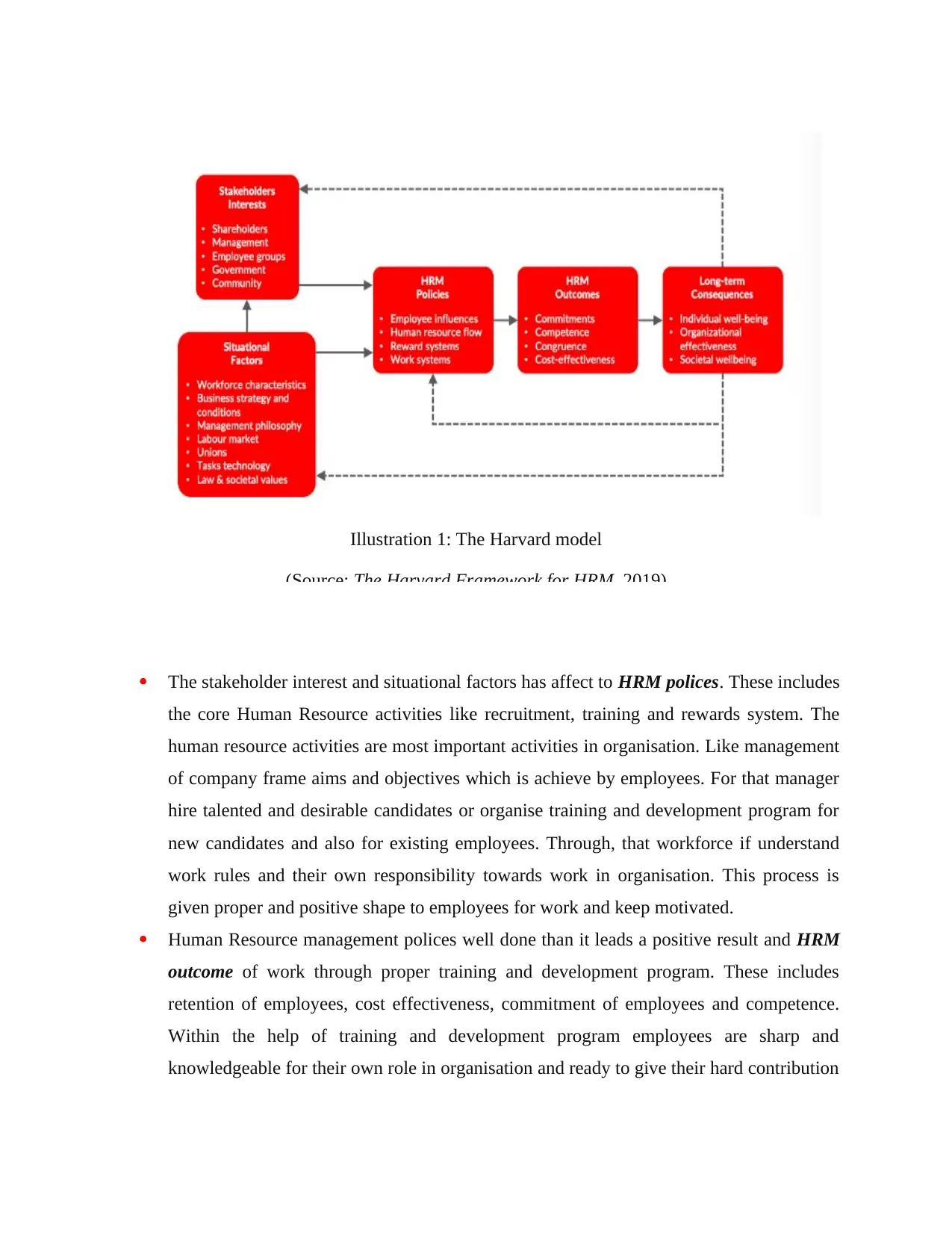
The stakeholder interest and situational factors has affect to HRM polices. These includes
the core Human Resource activities like recruitment, training and rewards system. The
human resource activities are most important activities in organisation. Like management
of company frame aims and objectives which is achieve by employees. For that manager
hire talented and desirable candidates or organise training and development program for
new candidates and also for existing employees. Through, that workforce if understand
work rules and their own responsibility towards work in organisation. This process is
given proper and positive shape to employees for work and keep motivated.
Human Resource management polices well done than it leads a positive result and HRM
outcome of work through proper training and development program. These includes
retention of employees, cost effectiveness, commitment of employees and competence.
Within the help of training and development program employees are sharp and
knowledgeable for their own role in organisation and ready to give their hard contribution
Illustration 1: The Harvard model
(Source: The Harvard Framework for HRM, 2019)
the core Human Resource activities like recruitment, training and rewards system. The
human resource activities are most important activities in organisation. Like management
of company frame aims and objectives which is achieve by employees. For that manager
hire talented and desirable candidates or organise training and development program for
new candidates and also for existing employees. Through, that workforce if understand
work rules and their own responsibility towards work in organisation. This process is
given proper and positive shape to employees for work and keep motivated.
Human Resource management polices well done than it leads a positive result and HRM
outcome of work through proper training and development program. These includes
retention of employees, cost effectiveness, commitment of employees and competence.
Within the help of training and development program employees are sharp and
knowledgeable for their own role in organisation and ready to give their hard contribution
Illustration 1: The Harvard model
(Source: The Harvard Framework for HRM, 2019)
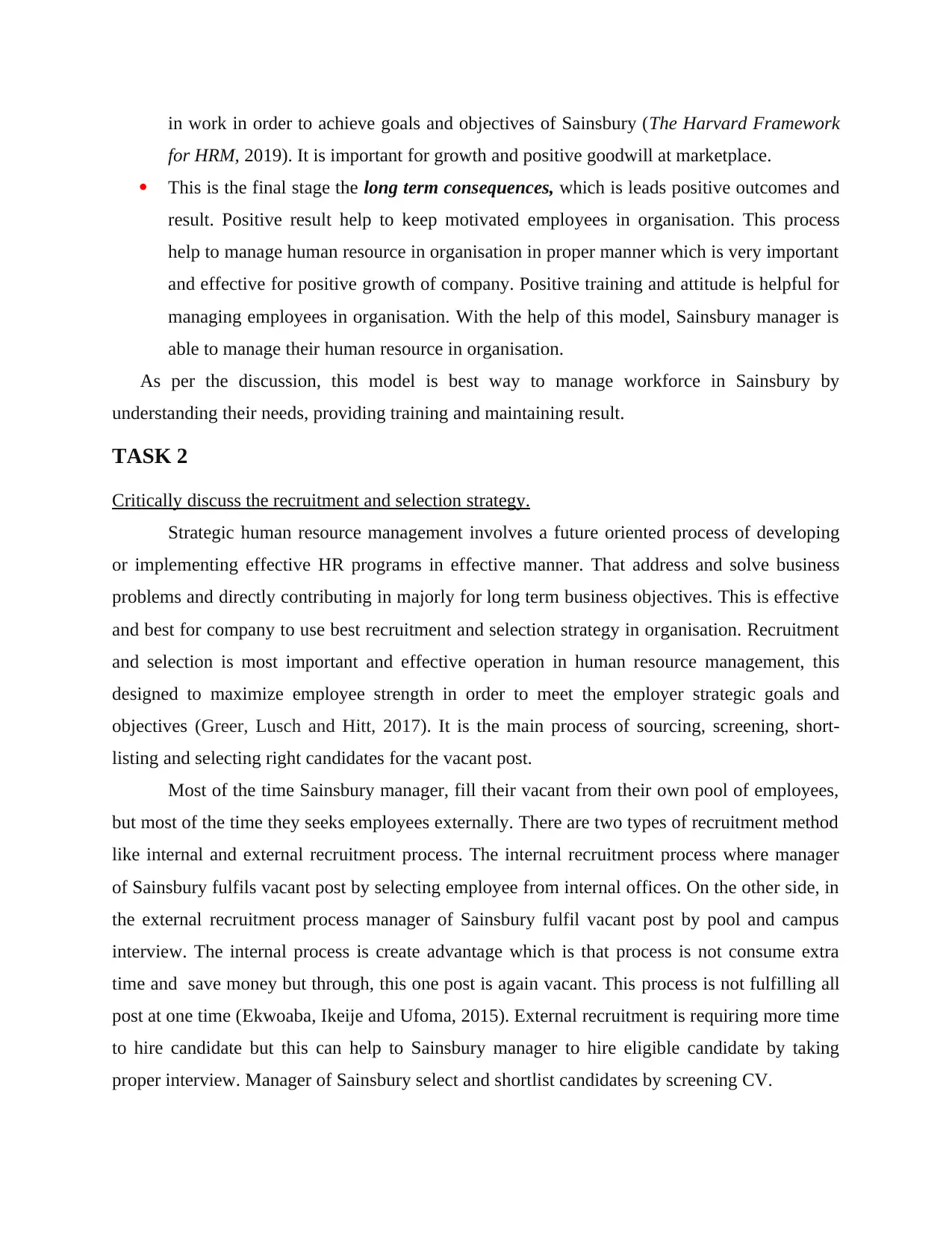
in work in order to achieve goals and objectives of Sainsbury (The Harvard Framework
for HRM, 2019). It is important for growth and positive goodwill at marketplace.
This is the final stage the long term consequences, which is leads positive outcomes and
result. Positive result help to keep motivated employees in organisation. This process
help to manage human resource in organisation in proper manner which is very important
and effective for positive growth of company. Positive training and attitude is helpful for
managing employees in organisation. With the help of this model, Sainsbury manager is
able to manage their human resource in organisation.
As per the discussion, this model is best way to manage workforce in Sainsbury by
understanding their needs, providing training and maintaining result.
TASK 2
Critically discuss the recruitment and selection strategy.
Strategic human resource management involves a future oriented process of developing
or implementing effective HR programs in effective manner. That address and solve business
problems and directly contributing in majorly for long term business objectives. This is effective
and best for company to use best recruitment and selection strategy in organisation. Recruitment
and selection is most important and effective operation in human resource management, this
designed to maximize employee strength in order to meet the employer strategic goals and
objectives (Greer, Lusch and Hitt, 2017). It is the main process of sourcing, screening, short-
listing and selecting right candidates for the vacant post.
Most of the time Sainsbury manager, fill their vacant from their own pool of employees,
but most of the time they seeks employees externally. There are two types of recruitment method
like internal and external recruitment process. The internal recruitment process where manager
of Sainsbury fulfils vacant post by selecting employee from internal offices. On the other side, in
the external recruitment process manager of Sainsbury fulfil vacant post by pool and campus
interview. The internal process is create advantage which is that process is not consume extra
time and save money but through, this one post is again vacant. This process is not fulfilling all
post at one time (Ekwoaba, Ikeije and Ufoma, 2015). External recruitment is requiring more time
to hire candidate but this can help to Sainsbury manager to hire eligible candidate by taking
proper interview. Manager of Sainsbury select and shortlist candidates by screening CV.
for HRM, 2019). It is important for growth and positive goodwill at marketplace.
This is the final stage the long term consequences, which is leads positive outcomes and
result. Positive result help to keep motivated employees in organisation. This process
help to manage human resource in organisation in proper manner which is very important
and effective for positive growth of company. Positive training and attitude is helpful for
managing employees in organisation. With the help of this model, Sainsbury manager is
able to manage their human resource in organisation.
As per the discussion, this model is best way to manage workforce in Sainsbury by
understanding their needs, providing training and maintaining result.
TASK 2
Critically discuss the recruitment and selection strategy.
Strategic human resource management involves a future oriented process of developing
or implementing effective HR programs in effective manner. That address and solve business
problems and directly contributing in majorly for long term business objectives. This is effective
and best for company to use best recruitment and selection strategy in organisation. Recruitment
and selection is most important and effective operation in human resource management, this
designed to maximize employee strength in order to meet the employer strategic goals and
objectives (Greer, Lusch and Hitt, 2017). It is the main process of sourcing, screening, short-
listing and selecting right candidates for the vacant post.
Most of the time Sainsbury manager, fill their vacant from their own pool of employees,
but most of the time they seeks employees externally. There are two types of recruitment method
like internal and external recruitment process. The internal recruitment process where manager
of Sainsbury fulfils vacant post by selecting employee from internal offices. On the other side, in
the external recruitment process manager of Sainsbury fulfil vacant post by pool and campus
interview. The internal process is create advantage which is that process is not consume extra
time and save money but through, this one post is again vacant. This process is not fulfilling all
post at one time (Ekwoaba, Ikeije and Ufoma, 2015). External recruitment is requiring more time
to hire candidate but this can help to Sainsbury manager to hire eligible candidate by taking
proper interview. Manager of Sainsbury select and shortlist candidates by screening CV.
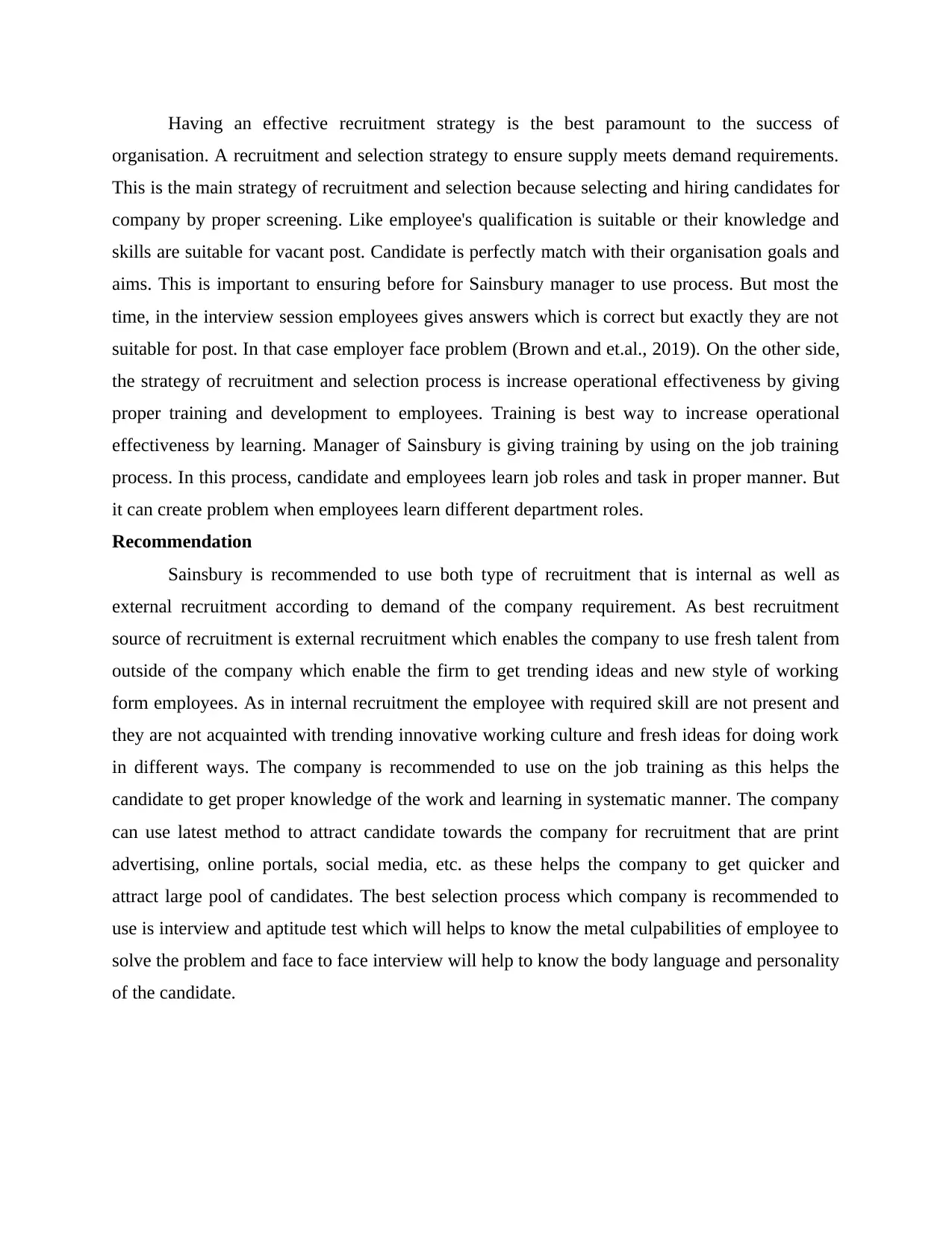
Having an effective recruitment strategy is the best paramount to the success of
organisation. A recruitment and selection strategy to ensure supply meets demand requirements.
This is the main strategy of recruitment and selection because selecting and hiring candidates for
company by proper screening. Like employee's qualification is suitable or their knowledge and
skills are suitable for vacant post. Candidate is perfectly match with their organisation goals and
aims. This is important to ensuring before for Sainsbury manager to use process. But most the
time, in the interview session employees gives answers which is correct but exactly they are not
suitable for post. In that case employer face problem (Brown and et.al., 2019). On the other side,
the strategy of recruitment and selection process is increase operational effectiveness by giving
proper training and development to employees. Training is best way to increase operational
effectiveness by learning. Manager of Sainsbury is giving training by using on the job training
process. In this process, candidate and employees learn job roles and task in proper manner. But
it can create problem when employees learn different department roles.
Recommendation
Sainsbury is recommended to use both type of recruitment that is internal as well as
external recruitment according to demand of the company requirement. As best recruitment
source of recruitment is external recruitment which enables the company to use fresh talent from
outside of the company which enable the firm to get trending ideas and new style of working
form employees. As in internal recruitment the employee with required skill are not present and
they are not acquainted with trending innovative working culture and fresh ideas for doing work
in different ways. The company is recommended to use on the job training as this helps the
candidate to get proper knowledge of the work and learning in systematic manner. The company
can use latest method to attract candidate towards the company for recruitment that are print
advertising, online portals, social media, etc. as these helps the company to get quicker and
attract large pool of candidates. The best selection process which company is recommended to
use is interview and aptitude test which will helps to know the metal culpabilities of employee to
solve the problem and face to face interview will help to know the body language and personality
of the candidate.
organisation. A recruitment and selection strategy to ensure supply meets demand requirements.
This is the main strategy of recruitment and selection because selecting and hiring candidates for
company by proper screening. Like employee's qualification is suitable or their knowledge and
skills are suitable for vacant post. Candidate is perfectly match with their organisation goals and
aims. This is important to ensuring before for Sainsbury manager to use process. But most the
time, in the interview session employees gives answers which is correct but exactly they are not
suitable for post. In that case employer face problem (Brown and et.al., 2019). On the other side,
the strategy of recruitment and selection process is increase operational effectiveness by giving
proper training and development to employees. Training is best way to increase operational
effectiveness by learning. Manager of Sainsbury is giving training by using on the job training
process. In this process, candidate and employees learn job roles and task in proper manner. But
it can create problem when employees learn different department roles.
Recommendation
Sainsbury is recommended to use both type of recruitment that is internal as well as
external recruitment according to demand of the company requirement. As best recruitment
source of recruitment is external recruitment which enables the company to use fresh talent from
outside of the company which enable the firm to get trending ideas and new style of working
form employees. As in internal recruitment the employee with required skill are not present and
they are not acquainted with trending innovative working culture and fresh ideas for doing work
in different ways. The company is recommended to use on the job training as this helps the
candidate to get proper knowledge of the work and learning in systematic manner. The company
can use latest method to attract candidate towards the company for recruitment that are print
advertising, online portals, social media, etc. as these helps the company to get quicker and
attract large pool of candidates. The best selection process which company is recommended to
use is interview and aptitude test which will helps to know the metal culpabilities of employee to
solve the problem and face to face interview will help to know the body language and personality
of the candidate.
Paraphrase This Document
Need a fresh take? Get an instant paraphrase of this document with our AI Paraphraser
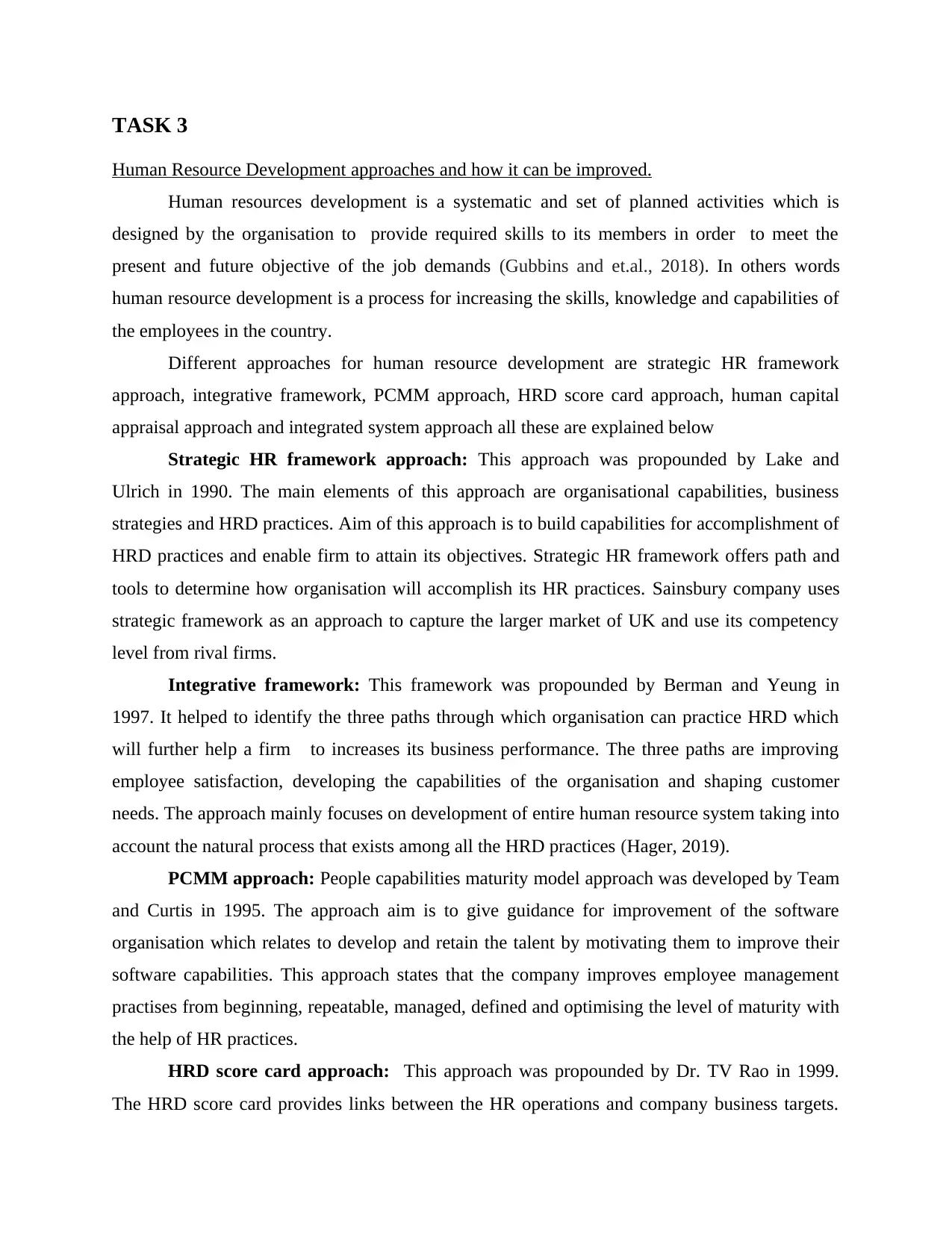
TASK 3
Human Resource Development approaches and how it can be improved.
Human resources development is a systematic and set of planned activities which is
designed by the organisation to provide required skills to its members in order to meet the
present and future objective of the job demands (Gubbins and et.al., 2018). In others words
human resource development is a process for increasing the skills, knowledge and capabilities of
the employees in the country.
Different approaches for human resource development are strategic HR framework
approach, integrative framework, PCMM approach, HRD score card approach, human capital
appraisal approach and integrated system approach all these are explained below
Strategic HR framework approach: This approach was propounded by Lake and
Ulrich in 1990. The main elements of this approach are organisational capabilities, business
strategies and HRD practices. Aim of this approach is to build capabilities for accomplishment of
HRD practices and enable firm to attain its objectives. Strategic HR framework offers path and
tools to determine how organisation will accomplish its HR practices. Sainsbury company uses
strategic framework as an approach to capture the larger market of UK and use its competency
level from rival firms.
Integrative framework: This framework was propounded by Berman and Yeung in
1997. It helped to identify the three paths through which organisation can practice HRD which
will further help a firm to increases its business performance. The three paths are improving
employee satisfaction, developing the capabilities of the organisation and shaping customer
needs. The approach mainly focuses on development of entire human resource system taking into
account the natural process that exists among all the HRD practices (Hager, 2019).
PCMM approach: People capabilities maturity model approach was developed by Team
and Curtis in 1995. The approach aim is to give guidance for improvement of the software
organisation which relates to develop and retain the talent by motivating them to improve their
software capabilities. This approach states that the company improves employee management
practises from beginning, repeatable, managed, defined and optimising the level of maturity with
the help of HR practices.
HRD score card approach: This approach was propounded by Dr. TV Rao in 1999.
The HRD score card provides links between the HR operations and company business targets.
Human Resource Development approaches and how it can be improved.
Human resources development is a systematic and set of planned activities which is
designed by the organisation to provide required skills to its members in order to meet the
present and future objective of the job demands (Gubbins and et.al., 2018). In others words
human resource development is a process for increasing the skills, knowledge and capabilities of
the employees in the country.
Different approaches for human resource development are strategic HR framework
approach, integrative framework, PCMM approach, HRD score card approach, human capital
appraisal approach and integrated system approach all these are explained below
Strategic HR framework approach: This approach was propounded by Lake and
Ulrich in 1990. The main elements of this approach are organisational capabilities, business
strategies and HRD practices. Aim of this approach is to build capabilities for accomplishment of
HRD practices and enable firm to attain its objectives. Strategic HR framework offers path and
tools to determine how organisation will accomplish its HR practices. Sainsbury company uses
strategic framework as an approach to capture the larger market of UK and use its competency
level from rival firms.
Integrative framework: This framework was propounded by Berman and Yeung in
1997. It helped to identify the three paths through which organisation can practice HRD which
will further help a firm to increases its business performance. The three paths are improving
employee satisfaction, developing the capabilities of the organisation and shaping customer
needs. The approach mainly focuses on development of entire human resource system taking into
account the natural process that exists among all the HRD practices (Hager, 2019).
PCMM approach: People capabilities maturity model approach was developed by Team
and Curtis in 1995. The approach aim is to give guidance for improvement of the software
organisation which relates to develop and retain the talent by motivating them to improve their
software capabilities. This approach states that the company improves employee management
practises from beginning, repeatable, managed, defined and optimising the level of maturity with
the help of HR practices.
HRD score card approach: This approach was propounded by Dr. TV Rao in 1999.
The HRD score card provides links between the HR operations and company business targets.
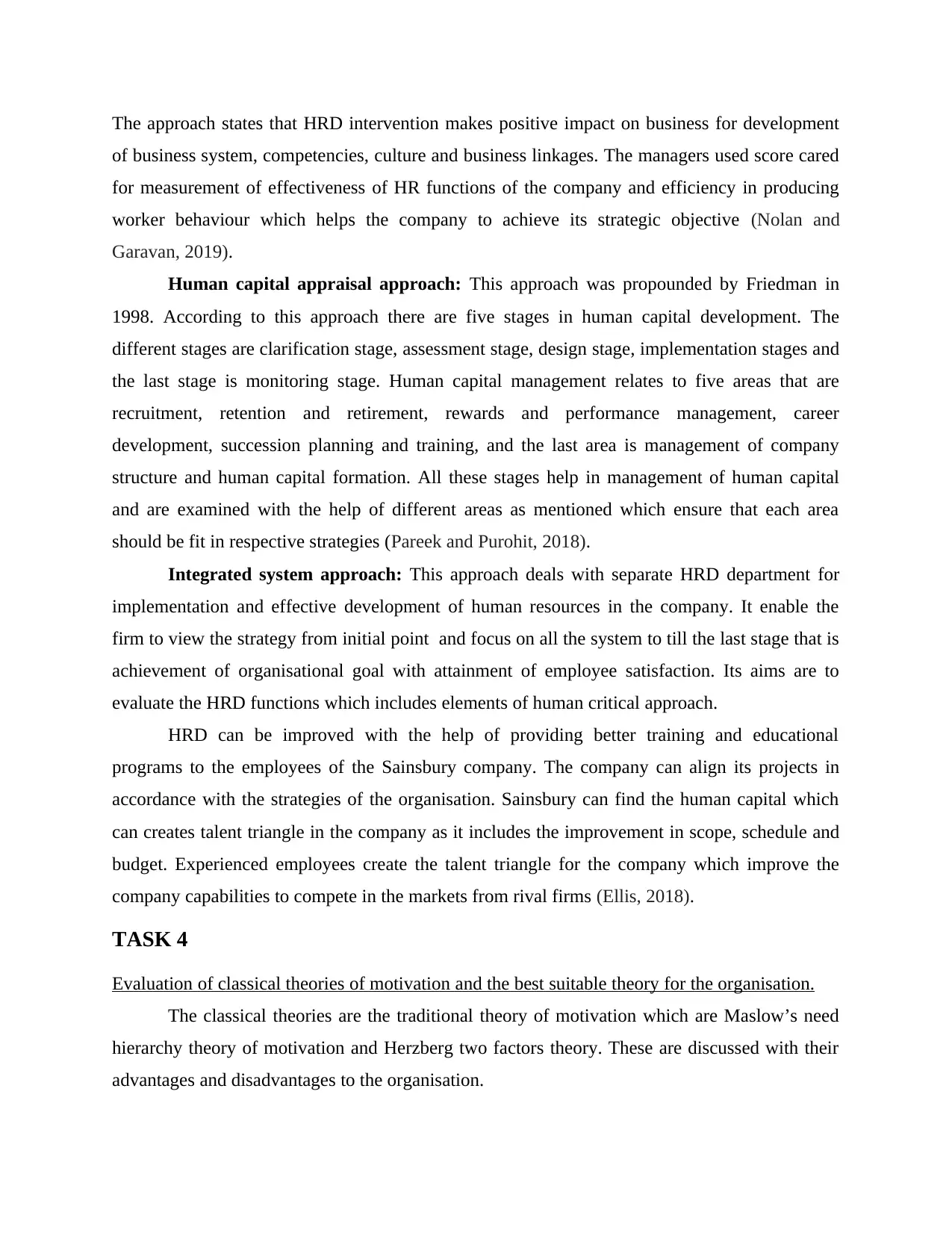
The approach states that HRD intervention makes positive impact on business for development
of business system, competencies, culture and business linkages. The managers used score cared
for measurement of effectiveness of HR functions of the company and efficiency in producing
worker behaviour which helps the company to achieve its strategic objective (Nolan and
Garavan, 2019).
Human capital appraisal approach: This approach was propounded by Friedman in
1998. According to this approach there are five stages in human capital development. The
different stages are clarification stage, assessment stage, design stage, implementation stages and
the last stage is monitoring stage. Human capital management relates to five areas that are
recruitment, retention and retirement, rewards and performance management, career
development, succession planning and training, and the last area is management of company
structure and human capital formation. All these stages help in management of human capital
and are examined with the help of different areas as mentioned which ensure that each area
should be fit in respective strategies (Pareek and Purohit, 2018).
Integrated system approach: This approach deals with separate HRD department for
implementation and effective development of human resources in the company. It enable the
firm to view the strategy from initial point and focus on all the system to till the last stage that is
achievement of organisational goal with attainment of employee satisfaction. Its aims are to
evaluate the HRD functions which includes elements of human critical approach.
HRD can be improved with the help of providing better training and educational
programs to the employees of the Sainsbury company. The company can align its projects in
accordance with the strategies of the organisation. Sainsbury can find the human capital which
can creates talent triangle in the company as it includes the improvement in scope, schedule and
budget. Experienced employees create the talent triangle for the company which improve the
company capabilities to compete in the markets from rival firms (Ellis, 2018).
TASK 4
Evaluation of classical theories of motivation and the best suitable theory for the organisation.
The classical theories are the traditional theory of motivation which are Maslow’s need
hierarchy theory of motivation and Herzberg two factors theory. These are discussed with their
advantages and disadvantages to the organisation.
of business system, competencies, culture and business linkages. The managers used score cared
for measurement of effectiveness of HR functions of the company and efficiency in producing
worker behaviour which helps the company to achieve its strategic objective (Nolan and
Garavan, 2019).
Human capital appraisal approach: This approach was propounded by Friedman in
1998. According to this approach there are five stages in human capital development. The
different stages are clarification stage, assessment stage, design stage, implementation stages and
the last stage is monitoring stage. Human capital management relates to five areas that are
recruitment, retention and retirement, rewards and performance management, career
development, succession planning and training, and the last area is management of company
structure and human capital formation. All these stages help in management of human capital
and are examined with the help of different areas as mentioned which ensure that each area
should be fit in respective strategies (Pareek and Purohit, 2018).
Integrated system approach: This approach deals with separate HRD department for
implementation and effective development of human resources in the company. It enable the
firm to view the strategy from initial point and focus on all the system to till the last stage that is
achievement of organisational goal with attainment of employee satisfaction. Its aims are to
evaluate the HRD functions which includes elements of human critical approach.
HRD can be improved with the help of providing better training and educational
programs to the employees of the Sainsbury company. The company can align its projects in
accordance with the strategies of the organisation. Sainsbury can find the human capital which
can creates talent triangle in the company as it includes the improvement in scope, schedule and
budget. Experienced employees create the talent triangle for the company which improve the
company capabilities to compete in the markets from rival firms (Ellis, 2018).
TASK 4
Evaluation of classical theories of motivation and the best suitable theory for the organisation.
The classical theories are the traditional theory of motivation which are Maslow’s need
hierarchy theory of motivation and Herzberg two factors theory. These are discussed with their
advantages and disadvantages to the organisation.
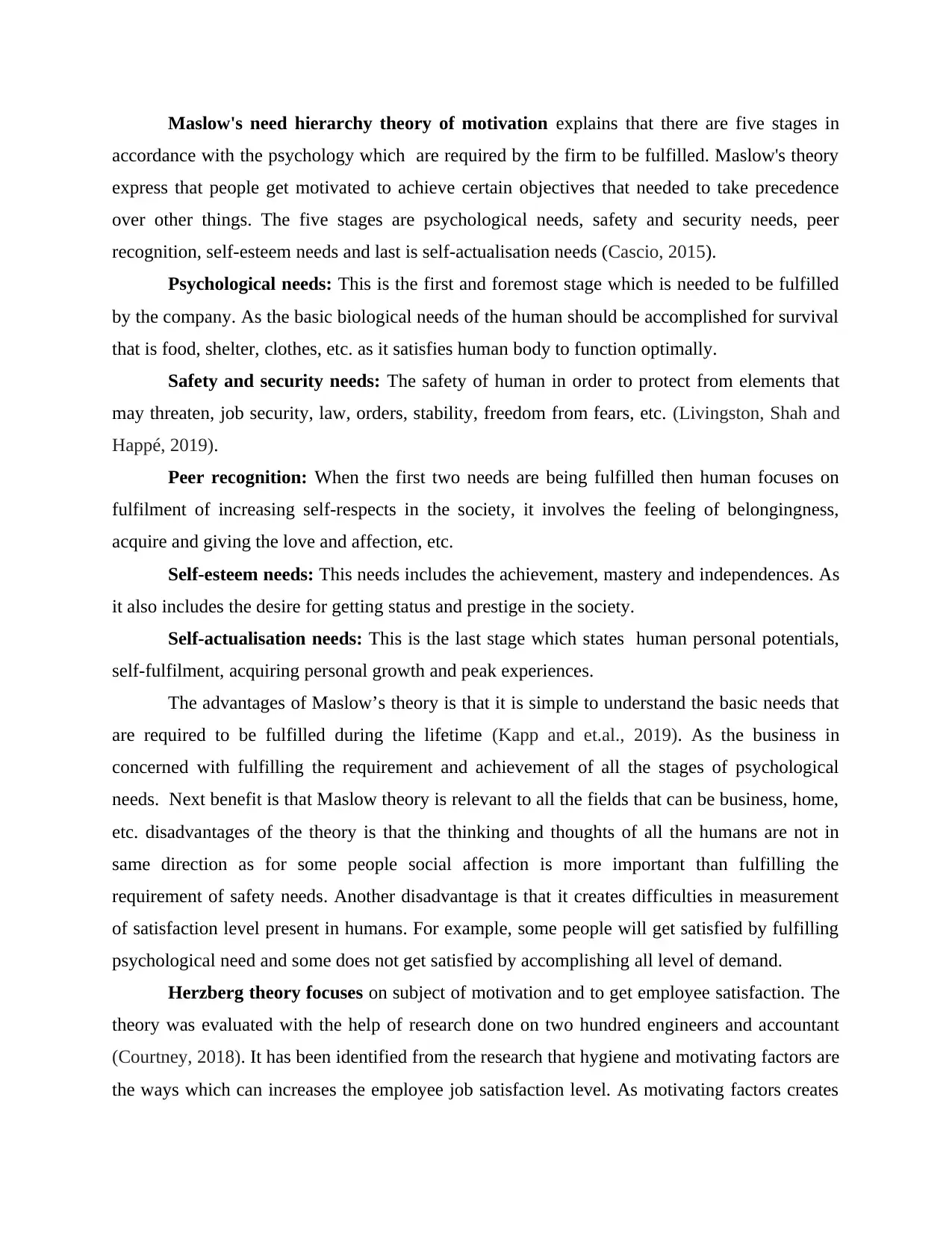
Maslow's need hierarchy theory of motivation explains that there are five stages in
accordance with the psychology which are required by the firm to be fulfilled. Maslow's theory
express that people get motivated to achieve certain objectives that needed to take precedence
over other things. The five stages are psychological needs, safety and security needs, peer
recognition, self-esteem needs and last is self-actualisation needs (Cascio, 2015).
Psychological needs: This is the first and foremost stage which is needed to be fulfilled
by the company. As the basic biological needs of the human should be accomplished for survival
that is food, shelter, clothes, etc. as it satisfies human body to function optimally.
Safety and security needs: The safety of human in order to protect from elements that
may threaten, job security, law, orders, stability, freedom from fears, etc. (Livingston, Shah and
Happé, 2019).
Peer recognition: When the first two needs are being fulfilled then human focuses on
fulfilment of increasing self-respects in the society, it involves the feeling of belongingness,
acquire and giving the love and affection, etc.
Self-esteem needs: This needs includes the achievement, mastery and independences. As
it also includes the desire for getting status and prestige in the society.
Self-actualisation needs: This is the last stage which states human personal potentials,
self-fulfilment, acquiring personal growth and peak experiences.
The advantages of Maslow’s theory is that it is simple to understand the basic needs that
are required to be fulfilled during the lifetime (Kapp and et.al., 2019). As the business in
concerned with fulfilling the requirement and achievement of all the stages of psychological
needs. Next benefit is that Maslow theory is relevant to all the fields that can be business, home,
etc. disadvantages of the theory is that the thinking and thoughts of all the humans are not in
same direction as for some people social affection is more important than fulfilling the
requirement of safety needs. Another disadvantage is that it creates difficulties in measurement
of satisfaction level present in humans. For example, some people will get satisfied by fulfilling
psychological need and some does not get satisfied by accomplishing all level of demand.
Herzberg theory focuses on subject of motivation and to get employee satisfaction. The
theory was evaluated with the help of research done on two hundred engineers and accountant
(Courtney, 2018). It has been identified from the research that hygiene and motivating factors are
the ways which can increases the employee job satisfaction level. As motivating factors creates
accordance with the psychology which are required by the firm to be fulfilled. Maslow's theory
express that people get motivated to achieve certain objectives that needed to take precedence
over other things. The five stages are psychological needs, safety and security needs, peer
recognition, self-esteem needs and last is self-actualisation needs (Cascio, 2015).
Psychological needs: This is the first and foremost stage which is needed to be fulfilled
by the company. As the basic biological needs of the human should be accomplished for survival
that is food, shelter, clothes, etc. as it satisfies human body to function optimally.
Safety and security needs: The safety of human in order to protect from elements that
may threaten, job security, law, orders, stability, freedom from fears, etc. (Livingston, Shah and
Happé, 2019).
Peer recognition: When the first two needs are being fulfilled then human focuses on
fulfilment of increasing self-respects in the society, it involves the feeling of belongingness,
acquire and giving the love and affection, etc.
Self-esteem needs: This needs includes the achievement, mastery and independences. As
it also includes the desire for getting status and prestige in the society.
Self-actualisation needs: This is the last stage which states human personal potentials,
self-fulfilment, acquiring personal growth and peak experiences.
The advantages of Maslow’s theory is that it is simple to understand the basic needs that
are required to be fulfilled during the lifetime (Kapp and et.al., 2019). As the business in
concerned with fulfilling the requirement and achievement of all the stages of psychological
needs. Next benefit is that Maslow theory is relevant to all the fields that can be business, home,
etc. disadvantages of the theory is that the thinking and thoughts of all the humans are not in
same direction as for some people social affection is more important than fulfilling the
requirement of safety needs. Another disadvantage is that it creates difficulties in measurement
of satisfaction level present in humans. For example, some people will get satisfied by fulfilling
psychological need and some does not get satisfied by accomplishing all level of demand.
Herzberg theory focuses on subject of motivation and to get employee satisfaction. The
theory was evaluated with the help of research done on two hundred engineers and accountant
(Courtney, 2018). It has been identified from the research that hygiene and motivating factors are
the ways which can increases the employee job satisfaction level. As motivating factors creates
Secure Best Marks with AI Grader
Need help grading? Try our AI Grader for instant feedback on your assignments.
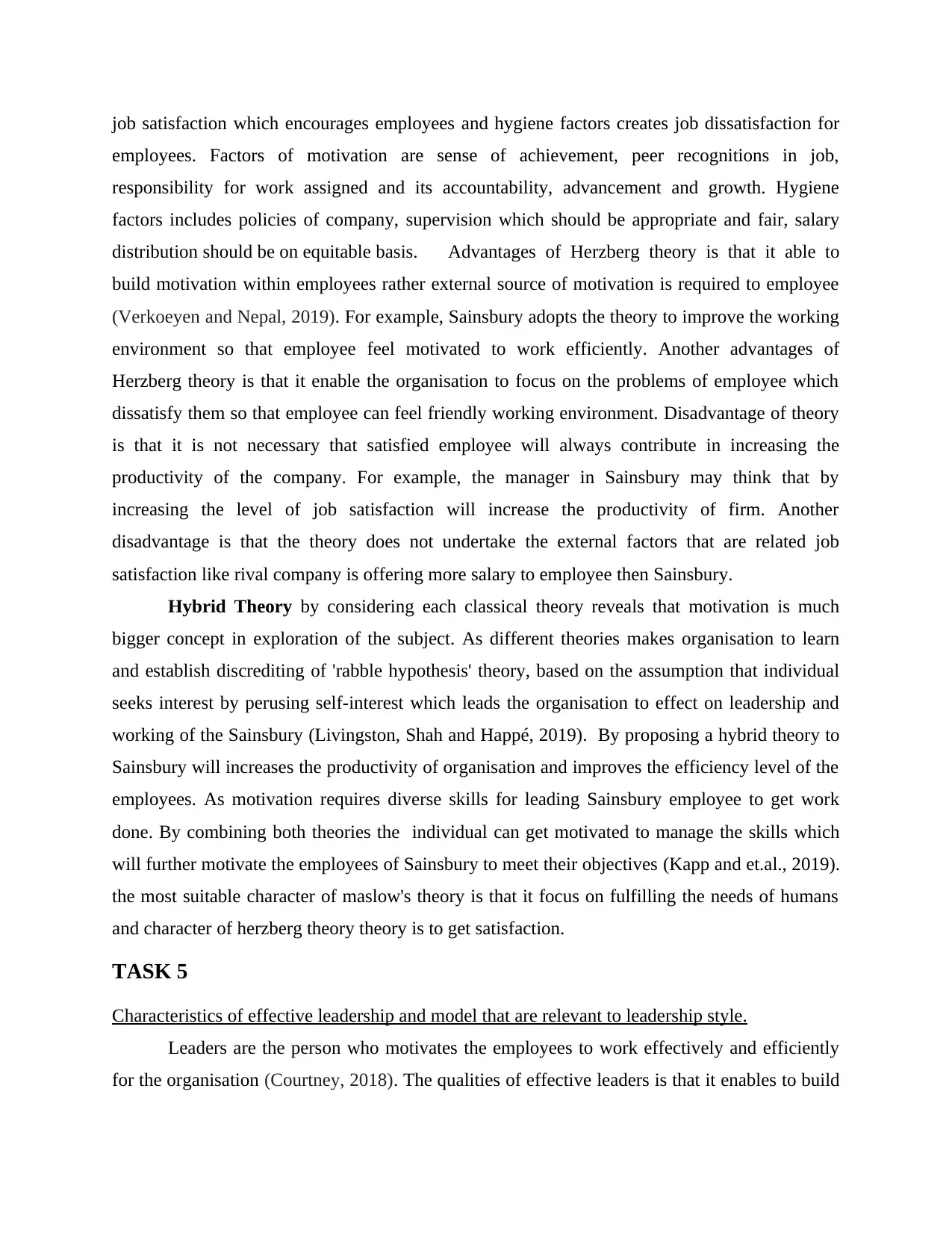
job satisfaction which encourages employees and hygiene factors creates job dissatisfaction for
employees. Factors of motivation are sense of achievement, peer recognitions in job,
responsibility for work assigned and its accountability, advancement and growth. Hygiene
factors includes policies of company, supervision which should be appropriate and fair, salary
distribution should be on equitable basis. Advantages of Herzberg theory is that it able to
build motivation within employees rather external source of motivation is required to employee
(Verkoeyen and Nepal, 2019). For example, Sainsbury adopts the theory to improve the working
environment so that employee feel motivated to work efficiently. Another advantages of
Herzberg theory is that it enable the organisation to focus on the problems of employee which
dissatisfy them so that employee can feel friendly working environment. Disadvantage of theory
is that it is not necessary that satisfied employee will always contribute in increasing the
productivity of the company. For example, the manager in Sainsbury may think that by
increasing the level of job satisfaction will increase the productivity of firm. Another
disadvantage is that the theory does not undertake the external factors that are related job
satisfaction like rival company is offering more salary to employee then Sainsbury.
Hybrid Theory by considering each classical theory reveals that motivation is much
bigger concept in exploration of the subject. As different theories makes organisation to learn
and establish discrediting of 'rabble hypothesis' theory, based on the assumption that individual
seeks interest by perusing self-interest which leads the organisation to effect on leadership and
working of the Sainsbury (Livingston, Shah and Happé, 2019). By proposing a hybrid theory to
Sainsbury will increases the productivity of organisation and improves the efficiency level of the
employees. As motivation requires diverse skills for leading Sainsbury employee to get work
done. By combining both theories the individual can get motivated to manage the skills which
will further motivate the employees of Sainsbury to meet their objectives (Kapp and et.al., 2019).
the most suitable character of maslow's theory is that it focus on fulfilling the needs of humans
and character of herzberg theory theory is to get satisfaction.
TASK 5
Characteristics of effective leadership and model that are relevant to leadership style.
Leaders are the person who motivates the employees to work effectively and efficiently
for the organisation (Courtney, 2018). The qualities of effective leaders is that it enables to build
employees. Factors of motivation are sense of achievement, peer recognitions in job,
responsibility for work assigned and its accountability, advancement and growth. Hygiene
factors includes policies of company, supervision which should be appropriate and fair, salary
distribution should be on equitable basis. Advantages of Herzberg theory is that it able to
build motivation within employees rather external source of motivation is required to employee
(Verkoeyen and Nepal, 2019). For example, Sainsbury adopts the theory to improve the working
environment so that employee feel motivated to work efficiently. Another advantages of
Herzberg theory is that it enable the organisation to focus on the problems of employee which
dissatisfy them so that employee can feel friendly working environment. Disadvantage of theory
is that it is not necessary that satisfied employee will always contribute in increasing the
productivity of the company. For example, the manager in Sainsbury may think that by
increasing the level of job satisfaction will increase the productivity of firm. Another
disadvantage is that the theory does not undertake the external factors that are related job
satisfaction like rival company is offering more salary to employee then Sainsbury.
Hybrid Theory by considering each classical theory reveals that motivation is much
bigger concept in exploration of the subject. As different theories makes organisation to learn
and establish discrediting of 'rabble hypothesis' theory, based on the assumption that individual
seeks interest by perusing self-interest which leads the organisation to effect on leadership and
working of the Sainsbury (Livingston, Shah and Happé, 2019). By proposing a hybrid theory to
Sainsbury will increases the productivity of organisation and improves the efficiency level of the
employees. As motivation requires diverse skills for leading Sainsbury employee to get work
done. By combining both theories the individual can get motivated to manage the skills which
will further motivate the employees of Sainsbury to meet their objectives (Kapp and et.al., 2019).
the most suitable character of maslow's theory is that it focus on fulfilling the needs of humans
and character of herzberg theory theory is to get satisfaction.
TASK 5
Characteristics of effective leadership and model that are relevant to leadership style.
Leaders are the person who motivates the employees to work effectively and efficiently
for the organisation (Courtney, 2018). The qualities of effective leaders is that it enables to build
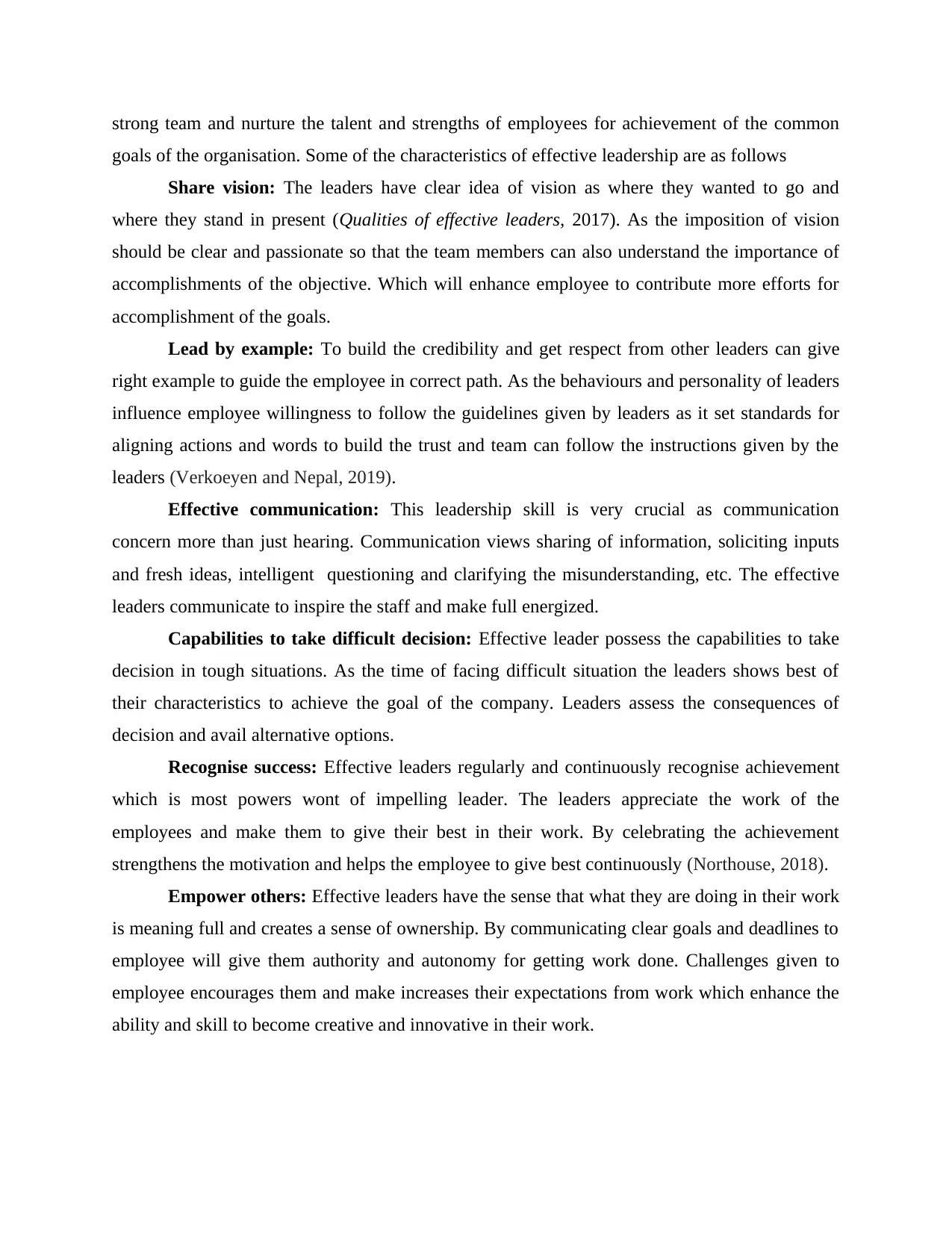
strong team and nurture the talent and strengths of employees for achievement of the common
goals of the organisation. Some of the characteristics of effective leadership are as follows
Share vision: The leaders have clear idea of vision as where they wanted to go and
where they stand in present (Qualities of effective leaders, 2017). As the imposition of vision
should be clear and passionate so that the team members can also understand the importance of
accomplishments of the objective. Which will enhance employee to contribute more efforts for
accomplishment of the goals.
Lead by example: To build the credibility and get respect from other leaders can give
right example to guide the employee in correct path. As the behaviours and personality of leaders
influence employee willingness to follow the guidelines given by leaders as it set standards for
aligning actions and words to build the trust and team can follow the instructions given by the
leaders (Verkoeyen and Nepal, 2019).
Effective communication: This leadership skill is very crucial as communication
concern more than just hearing. Communication views sharing of information, soliciting inputs
and fresh ideas, intelligent questioning and clarifying the misunderstanding, etc. The effective
leaders communicate to inspire the staff and make full energized.
Capabilities to take difficult decision: Effective leader possess the capabilities to take
decision in tough situations. As the time of facing difficult situation the leaders shows best of
their characteristics to achieve the goal of the company. Leaders assess the consequences of
decision and avail alternative options.
Recognise success: Effective leaders regularly and continuously recognise achievement
which is most powers wont of impelling leader. The leaders appreciate the work of the
employees and make them to give their best in their work. By celebrating the achievement
strengthens the motivation and helps the employee to give best continuously (Northouse, 2018).
Empower others: Effective leaders have the sense that what they are doing in their work
is meaning full and creates a sense of ownership. By communicating clear goals and deadlines to
employee will give them authority and autonomy for getting work done. Challenges given to
employee encourages them and make increases their expectations from work which enhance the
ability and skill to become creative and innovative in their work.
goals of the organisation. Some of the characteristics of effective leadership are as follows
Share vision: The leaders have clear idea of vision as where they wanted to go and
where they stand in present (Qualities of effective leaders, 2017). As the imposition of vision
should be clear and passionate so that the team members can also understand the importance of
accomplishments of the objective. Which will enhance employee to contribute more efforts for
accomplishment of the goals.
Lead by example: To build the credibility and get respect from other leaders can give
right example to guide the employee in correct path. As the behaviours and personality of leaders
influence employee willingness to follow the guidelines given by leaders as it set standards for
aligning actions and words to build the trust and team can follow the instructions given by the
leaders (Verkoeyen and Nepal, 2019).
Effective communication: This leadership skill is very crucial as communication
concern more than just hearing. Communication views sharing of information, soliciting inputs
and fresh ideas, intelligent questioning and clarifying the misunderstanding, etc. The effective
leaders communicate to inspire the staff and make full energized.
Capabilities to take difficult decision: Effective leader possess the capabilities to take
decision in tough situations. As the time of facing difficult situation the leaders shows best of
their characteristics to achieve the goal of the company. Leaders assess the consequences of
decision and avail alternative options.
Recognise success: Effective leaders regularly and continuously recognise achievement
which is most powers wont of impelling leader. The leaders appreciate the work of the
employees and make them to give their best in their work. By celebrating the achievement
strengthens the motivation and helps the employee to give best continuously (Northouse, 2018).
Empower others: Effective leaders have the sense that what they are doing in their work
is meaning full and creates a sense of ownership. By communicating clear goals and deadlines to
employee will give them authority and autonomy for getting work done. Challenges given to
employee encourages them and make increases their expectations from work which enhance the
ability and skill to become creative and innovative in their work.
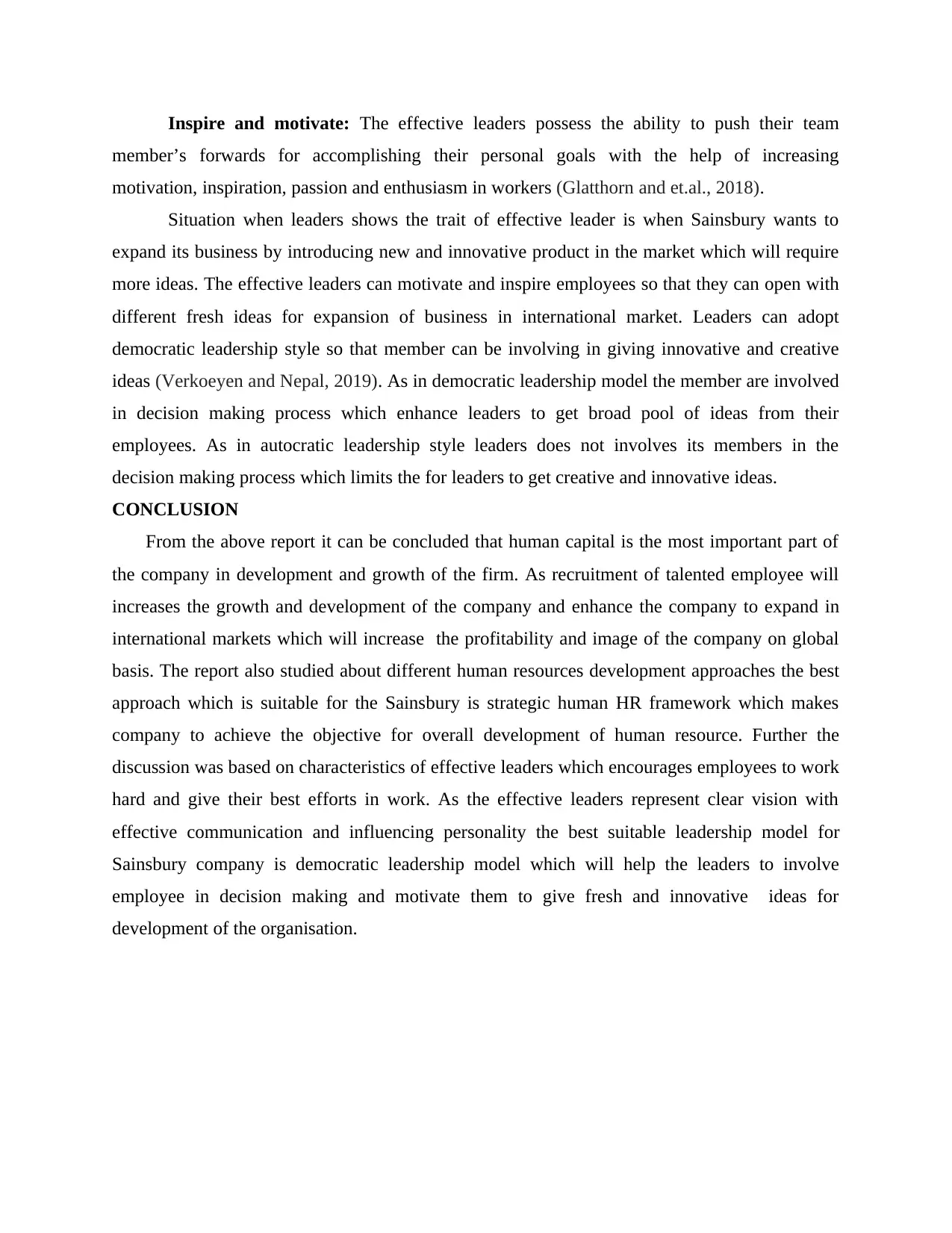
Inspire and motivate: The effective leaders possess the ability to push their team
member’s forwards for accomplishing their personal goals with the help of increasing
motivation, inspiration, passion and enthusiasm in workers (Glatthorn and et.al., 2018).
Situation when leaders shows the trait of effective leader is when Sainsbury wants to
expand its business by introducing new and innovative product in the market which will require
more ideas. The effective leaders can motivate and inspire employees so that they can open with
different fresh ideas for expansion of business in international market. Leaders can adopt
democratic leadership style so that member can be involving in giving innovative and creative
ideas (Verkoeyen and Nepal, 2019). As in democratic leadership model the member are involved
in decision making process which enhance leaders to get broad pool of ideas from their
employees. As in autocratic leadership style leaders does not involves its members in the
decision making process which limits the for leaders to get creative and innovative ideas.
CONCLUSION
From the above report it can be concluded that human capital is the most important part of
the company in development and growth of the firm. As recruitment of talented employee will
increases the growth and development of the company and enhance the company to expand in
international markets which will increase the profitability and image of the company on global
basis. The report also studied about different human resources development approaches the best
approach which is suitable for the Sainsbury is strategic human HR framework which makes
company to achieve the objective for overall development of human resource. Further the
discussion was based on characteristics of effective leaders which encourages employees to work
hard and give their best efforts in work. As the effective leaders represent clear vision with
effective communication and influencing personality the best suitable leadership model for
Sainsbury company is democratic leadership model which will help the leaders to involve
employee in decision making and motivate them to give fresh and innovative ideas for
development of the organisation.
member’s forwards for accomplishing their personal goals with the help of increasing
motivation, inspiration, passion and enthusiasm in workers (Glatthorn and et.al., 2018).
Situation when leaders shows the trait of effective leader is when Sainsbury wants to
expand its business by introducing new and innovative product in the market which will require
more ideas. The effective leaders can motivate and inspire employees so that they can open with
different fresh ideas for expansion of business in international market. Leaders can adopt
democratic leadership style so that member can be involving in giving innovative and creative
ideas (Verkoeyen and Nepal, 2019). As in democratic leadership model the member are involved
in decision making process which enhance leaders to get broad pool of ideas from their
employees. As in autocratic leadership style leaders does not involves its members in the
decision making process which limits the for leaders to get creative and innovative ideas.
CONCLUSION
From the above report it can be concluded that human capital is the most important part of
the company in development and growth of the firm. As recruitment of talented employee will
increases the growth and development of the company and enhance the company to expand in
international markets which will increase the profitability and image of the company on global
basis. The report also studied about different human resources development approaches the best
approach which is suitable for the Sainsbury is strategic human HR framework which makes
company to achieve the objective for overall development of human resource. Further the
discussion was based on characteristics of effective leaders which encourages employees to work
hard and give their best efforts in work. As the effective leaders represent clear vision with
effective communication and influencing personality the best suitable leadership model for
Sainsbury company is democratic leadership model which will help the leaders to involve
employee in decision making and motivate them to give fresh and innovative ideas for
development of the organisation.
Paraphrase This Document
Need a fresh take? Get an instant paraphrase of this document with our AI Paraphraser
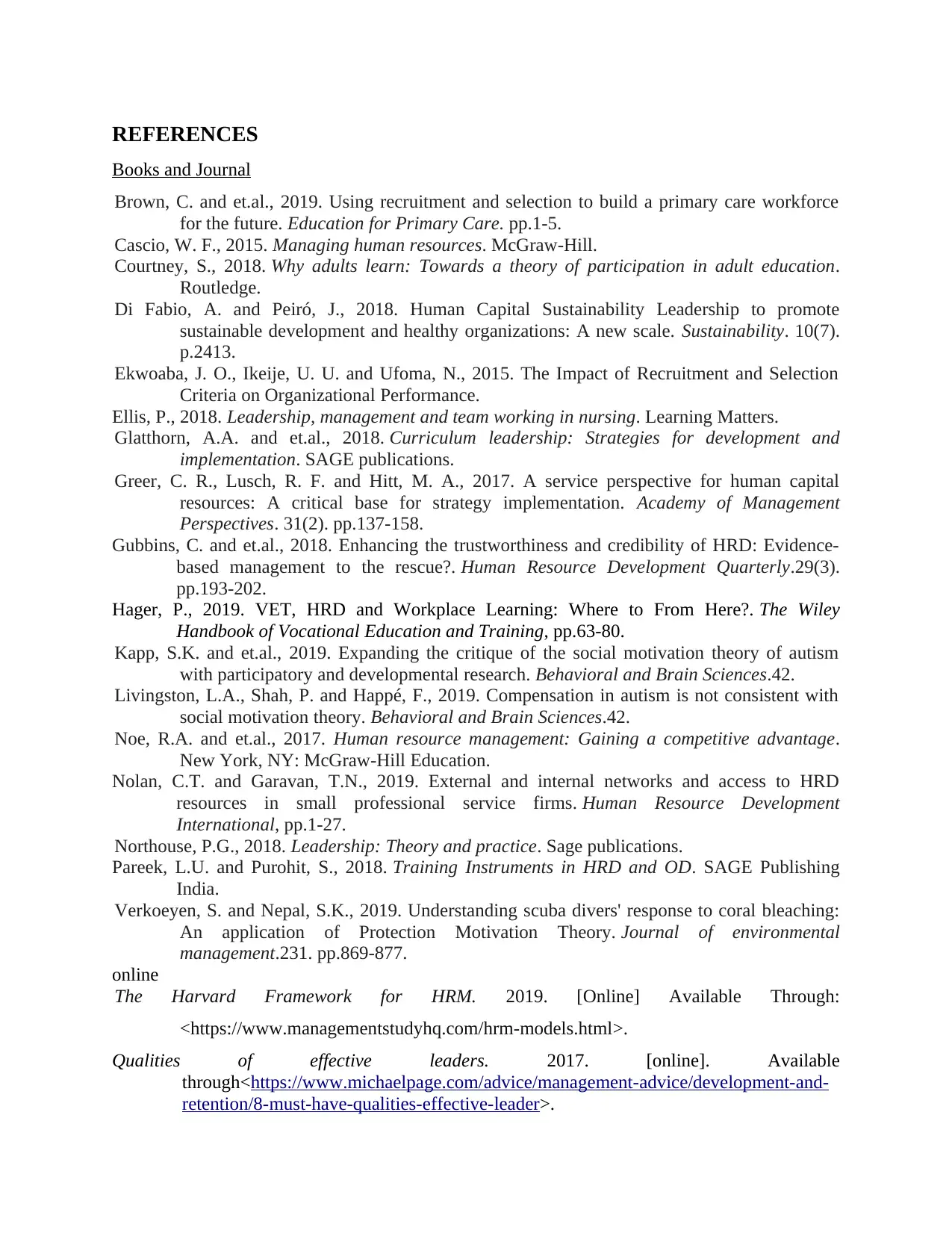
REFERENCES
Books and Journal
Brown, C. and et.al., 2019. Using recruitment and selection to build a primary care workforce
for the future. Education for Primary Care. pp.1-5.
Cascio, W. F., 2015. Managing human resources. McGraw-Hill.
Courtney, S., 2018. Why adults learn: Towards a theory of participation in adult education.
Routledge.
Di Fabio, A. and Peiró, J., 2018. Human Capital Sustainability Leadership to promote
sustainable development and healthy organizations: A new scale. Sustainability. 10(7).
p.2413.
Ekwoaba, J. O., Ikeije, U. U. and Ufoma, N., 2015. The Impact of Recruitment and Selection
Criteria on Organizational Performance.
Ellis, P., 2018. Leadership, management and team working in nursing. Learning Matters.
Glatthorn, A.A. and et.al., 2018. Curriculum leadership: Strategies for development and
implementation. SAGE publications.
Greer, C. R., Lusch, R. F. and Hitt, M. A., 2017. A service perspective for human capital
resources: A critical base for strategy implementation. Academy of Management
Perspectives. 31(2). pp.137-158.
Gubbins, C. and et.al., 2018. Enhancing the trustworthiness and credibility of HRD: Evidence-
based management to the rescue?. Human Resource Development Quarterly.29(3).
pp.193-202.
Hager, P., 2019. VET, HRD and Workplace Learning: Where to From Here?. The Wiley
Handbook of Vocational Education and Training, pp.63-80.
Kapp, S.K. and et.al., 2019. Expanding the critique of the social motivation theory of autism
with participatory and developmental research. Behavioral and Brain Sciences.42.
Livingston, L.A., Shah, P. and Happé, F., 2019. Compensation in autism is not consistent with
social motivation theory. Behavioral and Brain Sciences.42.
Noe, R.A. and et.al., 2017. Human resource management: Gaining a competitive advantage.
New York, NY: McGraw-Hill Education.
Nolan, C.T. and Garavan, T.N., 2019. External and internal networks and access to HRD
resources in small professional service firms. Human Resource Development
International, pp.1-27.
Northouse, P.G., 2018. Leadership: Theory and practice. Sage publications.
Pareek, L.U. and Purohit, S., 2018. Training Instruments in HRD and OD. SAGE Publishing
India.
Verkoeyen, S. and Nepal, S.K., 2019. Understanding scuba divers' response to coral bleaching:
An application of Protection Motivation Theory. Journal of environmental
management.231. pp.869-877.
online
The Harvard Framework for HRM. 2019. [Online] Available Through:
<https://www.managementstudyhq.com/hrm-models.html>.
Qualities of effective leaders. 2017. [online]. Available
through<https://www.michaelpage.com/advice/management-advice/development-and-
retention/8-must-have-qualities-effective-leader>.
Books and Journal
Brown, C. and et.al., 2019. Using recruitment and selection to build a primary care workforce
for the future. Education for Primary Care. pp.1-5.
Cascio, W. F., 2015. Managing human resources. McGraw-Hill.
Courtney, S., 2018. Why adults learn: Towards a theory of participation in adult education.
Routledge.
Di Fabio, A. and Peiró, J., 2018. Human Capital Sustainability Leadership to promote
sustainable development and healthy organizations: A new scale. Sustainability. 10(7).
p.2413.
Ekwoaba, J. O., Ikeije, U. U. and Ufoma, N., 2015. The Impact of Recruitment and Selection
Criteria on Organizational Performance.
Ellis, P., 2018. Leadership, management and team working in nursing. Learning Matters.
Glatthorn, A.A. and et.al., 2018. Curriculum leadership: Strategies for development and
implementation. SAGE publications.
Greer, C. R., Lusch, R. F. and Hitt, M. A., 2017. A service perspective for human capital
resources: A critical base for strategy implementation. Academy of Management
Perspectives. 31(2). pp.137-158.
Gubbins, C. and et.al., 2018. Enhancing the trustworthiness and credibility of HRD: Evidence-
based management to the rescue?. Human Resource Development Quarterly.29(3).
pp.193-202.
Hager, P., 2019. VET, HRD and Workplace Learning: Where to From Here?. The Wiley
Handbook of Vocational Education and Training, pp.63-80.
Kapp, S.K. and et.al., 2019. Expanding the critique of the social motivation theory of autism
with participatory and developmental research. Behavioral and Brain Sciences.42.
Livingston, L.A., Shah, P. and Happé, F., 2019. Compensation in autism is not consistent with
social motivation theory. Behavioral and Brain Sciences.42.
Noe, R.A. and et.al., 2017. Human resource management: Gaining a competitive advantage.
New York, NY: McGraw-Hill Education.
Nolan, C.T. and Garavan, T.N., 2019. External and internal networks and access to HRD
resources in small professional service firms. Human Resource Development
International, pp.1-27.
Northouse, P.G., 2018. Leadership: Theory and practice. Sage publications.
Pareek, L.U. and Purohit, S., 2018. Training Instruments in HRD and OD. SAGE Publishing
India.
Verkoeyen, S. and Nepal, S.K., 2019. Understanding scuba divers' response to coral bleaching:
An application of Protection Motivation Theory. Journal of environmental
management.231. pp.869-877.
online
The Harvard Framework for HRM. 2019. [Online] Available Through:
<https://www.managementstudyhq.com/hrm-models.html>.
Qualities of effective leaders. 2017. [online]. Available
through<https://www.michaelpage.com/advice/management-advice/development-and-
retention/8-must-have-qualities-effective-leader>.
1 out of 14
Related Documents
Your All-in-One AI-Powered Toolkit for Academic Success.
+13062052269
info@desklib.com
Available 24*7 on WhatsApp / Email
![[object Object]](/_next/static/media/star-bottom.7253800d.svg)
Unlock your academic potential
© 2024 | Zucol Services PVT LTD | All rights reserved.





